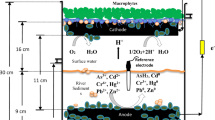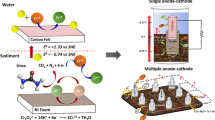Abstract
Purpose
As an attempt to remove the back color and odor of the organic-rich sediment, a novel tubular air-cathode MFC (TAC-MFC) was constructed and employed for in situ sediment remediation. The biodegradation of organic matter in sediment was stimulated by providing anodic electrode as an electron acceptor. The TAC-MFC was more favorable for application than typical sediment-type MFCs, whose performances are strongly limited due to the drawbacks such as low oxygen availability of cathodes, big electrode spacing, and fouling of cathodes.
Materials and methods
The TAC-MFC was constructed with a cloth cathode assembly (CCA) structure that consisted of a conductive, catalytic, and waterproof layer to replace the cathode and ionic exchange membrane in a typical MFC. By simply inserting TAC-MFC into the sediment, a whole electrochemical biosystem was established for simultaneous organic matter oxidization and electricity generation. The MFC performance for power generation and sediment bioremediation were evaluated under various external loadings, in terms of power density and the sediment quality parameters including loss on ignition (LOI), readily oxidizable organic matter (ROOM), and acid volatile sulfide (AVS).
Results and discussion
The highest power density (107.1 ± 8.6 mW/m2), coulombic efficiency (17.9%), and the lowest internal resistance (20 Ω) were obtained from the TAC-MFC that was loaded with an external resistance of 30 Ω. At the same time, LOI was decreased by about 33.1%, ROOM was decreased by about 36.0%, and AVS was decreased by about 94.9% in the sediment. Under closed circuit conditions, the oxidation and reduction potential value in the sediment increased from −162.5 to +245.7 mV, suggesting that an improved environment of sediment was achieved upon MFC treatment.
Conclusions
A higher power output was achieved in the proposed TAC-MFC compared with sediment-type MFCs reported in previous literature, indicating that the TAC-MFC with a CCA was a desirable configuration. From the analysis of sediment quality parameters, the proposed MFC was demonstrated to be a potential means for the sediment remediation coupled with electricity production.




Similar content being viewed by others
References
Aelterman P, Freguia S, Keller J, Verstraete W, Rabaey K (2008) The anode potential regurates bacterial activity in microbial fuel cells. Appl Microbiol Biotechnol 78:409–418
Brouwer H, Murphy TP (1994) Diffusion method for the determination of acid volatile sulphide in sediment. Environ Chem Toxicol 13:1273–1275
He Z, Shao HB, Angenent LT (2007) Increased power production from a sediment microbial fuel cell with a rotating cathode. Biosens Bioelectron 22:3252–3255
Hong SW, Chang IS, Choi YS, Kim BH, Chung TH (2009a) Responses from freshwater sediment during electricity generation using microbial fuel cells. Bioprocess Biosyst Eng 32:389–395
Hong SW, Chang IS, Choi YS, Kim BH, Chung TH (2009b) Experimental evaluation of influential factors for electricity harvesting from sediment using microbial fuel cell. Bioresour Technol 100:3029–3035
Jadhay GS, Ghangrekar MM (2009) Poerformance of microbial fuel cell subjected to variation in pH, temperature, external load and susbstrate concentration. Bioresour Technol 100:717–723
Jang JK, Pham TH, Chang IS, Kang KH, Moon H, Cho KS, Kim BH (2004) Construction and operation of a novel mediator- and membrane-less microbial fuel cell. Process Biochem 39:1007–1012
Kim JR, Premier GC, Hawkes FR, Dinsdale RM, Guwy AJ (2009) Development of a tubular microbial fuel cell (MFC) employing a membrane electrode assembly cathode. J Power Sources 187:393–399
Logan BE (2008) Microbial fuel cells. Wiley, New York
Loring DH, Rantala RTT (1992) Manual for the geochemical analyses of marine-sediments and suspended particulate matter. Earth Sci Rev 32:235–282
Morris JM, Jin S (2008) Feasibility of using microbial fuel cell technology for bioremediation of hydrocarbons in groundwater. J Environ Sci Health A 43:18–23
Morris JM, Jin S, Crimi B, Pruden A (2009) Microbial fuel cell in enhancing anaerobic biodegradation of diesel. Chem Eng J 146:161–167
Postgate JR (1984) The sulphate-reducing bacteria, 2nd edn. Cambridge University Press, Cambridge
Reimers CE, Tender LM, Fertig S, Wang W (2001) Harvesting energy from sediment-water interface. Environ Sci Technol 35:192–195
Rezaei F, Richard TL, Brennan RA, Logan BE (2007) Substrate-enhanced microbial fuel cells for improved remote power generation from sediment–based systems. Environ Sci Technol 41:4053–4058
Rulkens W (2005) Introduction of the treatment of polluted sediments. Rviews in Enivron Sci Bio/Technol 4:213–221
Ryckelynck N, Stecher HA, Reimers CE (2005) Understanding the anode mechanism of a seafloor fuel cell: interactions between geochemistry and microbial activity. Biogeochemistry 76:113–139
Saponaro S, Bonomo L (2003) Influence of environmental factors on the biological treatment of organic compounds in contaminated lagoon sediments. J Soils Sediments 3:165–172
Schamphelaire LD, Bossche LVD, Dang HS, Hoefte M, Boon N, Rabaey K, Verstraete W (2008) Microbial fuel cells generating electricity from rhizodeposits of rice plants. Environ Sci Technol 42:3053–3058
Vidali M (2001) Bioremediation. An overview. Pure Appl Chem 73:1163–1172
Zhang T, Gannon SM, Nevin KP, Franks AE, Lovley DR (2010) Stimulating the anaerobic degradation of aromatic hydrocarbons in contaminated sediments by providing an electrode as the electron acceptor. Environ Microbiol 12(4):1011–1020
Zhuang L, Zhou SG, Wang YQ, Liu CS, Geng S (2009) Membrane-less cloth cathode assembly (CCA) for scalable microbial fuel cells. Biosens Bioelectron 24:3652–3656
Acknowledgements
This study was supported jointly by The 863 Program of China (2009AA05Z115) and Guangdong Provincial Science-Technology Project (No. 2008A080800028 and 2008A030700004).
Author information
Authors and Affiliations
Corresponding author
Additional information
Responsible editor: Michael Kersten
Rights and permissions
About this article
Cite this article
Yuan, Y., Zhou, S. & Zhuang, L. A new approach to in situ sediment remediation based on air-cathode microbial fuel cells. J Soils Sediments 10, 1427–1433 (2010). https://doi.org/10.1007/s11368-010-0276-5
Received:
Accepted:
Published:
Issue Date:
DOI: https://doi.org/10.1007/s11368-010-0276-5




